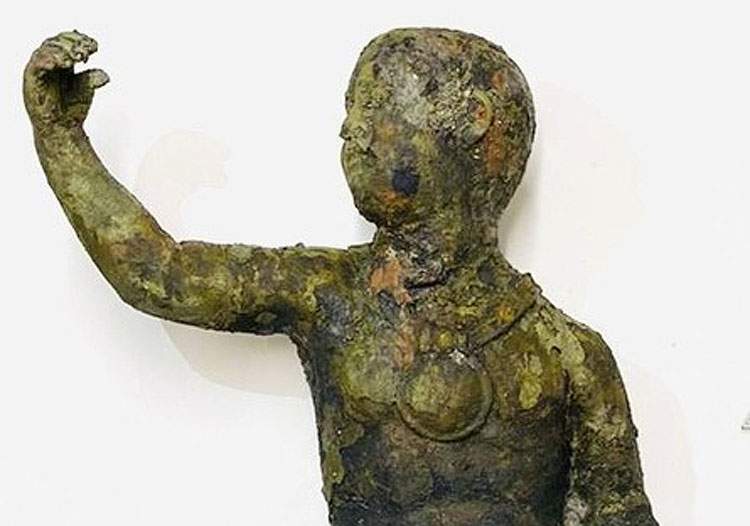San Casciano dei Bagni, votive deposit of Roman sanctuary found intact
The fourth excavation campaign at the Roman sanctuary of Bagno Grande in San Casciano dei Bagni conducted from June to August 2021 confirmed the importance of the site as a sanctuary rich in masterpieces of ancient art. Among the Roman altars of Isis, Fortuna Primigenia and Apollo, which archaeologists found resting on the edge of the sacred pool last year, the excavation team led by Jacopo Tabolli, an archaeological officer of the Soprintendenza, and Emanuele Mariotti, a professional archaeologist with expertise in topography and geophysics applied toarchaeology, with students, residents and doctoral students from the universities of Pisa, Siena, Florence, Rome La Sapienza and Sassari, reconstructed the abandoned phases of the complex, bringing to light part of the collapsed columns in the basin. Under the abandoned columns, the sanctuary’s votive deposit was found intact. Beneath the face of a large bull, masterfully carved in bas-relief on a block of the basin, offerings of worshippers who came to the sacred spring were found in the mud at a depth of more than two meters: hundreds of gold, silver, orichalc and bronze coins and a series of five sacred bronze figurines of offerers, including a Pan, and then bronze foil belts, miniature torches, and Hercules’ clubs.
The most outstanding piece is a bronze putto, an infant bearing the sacred bulla around its neck, probably made by an artist belonging to a very high school and influenced by Hellenizing models in the early second century BCE. The Putto of the Great Bath harks back to the famous Putto Graziani at the Vatican and, just like this one, on its right thigh is a mysterious ancient inscription celebrating the offering in the sanctuary and its divinity.
In addition, alongside the altars, excavation of the surface of the sacred pool has uncovered a series of “footprints” carved into the travertine, and filled with lead and traces of silver. These are feet of adults, youths and children, bull hooves and ears. Similar evidence is often linked to the “vestiges” of Isis and Serapis and may testify to an ancient rite of veneration at the spring where the worshipper, in walking in the footprints or placing his ear near the edge of the pool, entered into connection with the salutary deity. Toward the end of the second century A.D., next to the altars of the gods, Roman offerings at the shrine would have gone with leaden feet, and the gesture of their offering remained sealed on the true of the basin.
The Superintendence of Siena Grosseto and Arezzo is preparing an extensive archaeological landscape project dedicated to the protection , enhancement and enjoyment of the site, aimed at opening the sanctuary to the public. Also active since June 2021 is the Art Bonus project dedicated to the restoration and conservation of the sacred architecture of Bagno Grande.
Archaeological Officer Jacopo Tabolli said, “The path of research and protection of the Bagno Grande marks another fundamental step with these discoveries. The Superintendency, in fact, immediately bet on the excavation enterprise, recognizing in the multidisciplinarity and sharing of results the fundamental figure of the project. The group of researchers involved in the study and publication of the excavation exceeds forty scholars and has been enriched precisely in this fourth excavation campaign by colleagues who are tackling everything that archaeometric and archaeoenvironmental analyses can give us back. And since archaeology is not mail the work of a single individual, but the result of the efforts of many, the unexpected discoveries that have unfolded beneath us would never have been possible without the passion of the many students from Italian and foreign universities who over the past two years have accepted the challenge of dedicating a large part of their summers to complete a process of high education in field archaeology in a context such as that of Bagno Grande. Here where the layering is not only how much is excavated ’from above’ but also how much resurfaces via hot water ’from below’ is certainly a unique training ground for young archaeologists, and we are proud to still be able to offer moments like this.”
Excavation director Emanuele Mariotti added, “At the end of an exciting new excavation campaign, the first thought is thanks to all those who tackled this undertaking, in a spirit of self-sacrifice, loyalty and sharing. The enormous effort of all the participants, in a struggle against the mud and against time, had the goal of giving the territory of San Casciano dei Bagni and the entire community a new narrative made of data, research and emotions, made of archaeological masterpieces whose value we can begin to appreciate. The credit for this feat goes to all those who worked in the field, students, residents, friends and institutions, and all those who believed in this project from the beginning. The exceptional nature of the findings rewards this joint effort and contributes to rewriting the history not only of the area, but also of this part of Roman Etruria, with the hope that the rediscovery of the sanctuary may accompany us and give us new excitement for the coming years as well.”
 |
| San Casciano dei Bagni, votive deposit of Roman sanctuary found intact |
Warning: the translation into English of the original Italian article was created using automatic tools. We undertake to review all articles, but we do not guarantee the total absence of inaccuracies in the translation due to the program. You can find the original by clicking on the ITA button. If you find any mistake,please contact us.




























